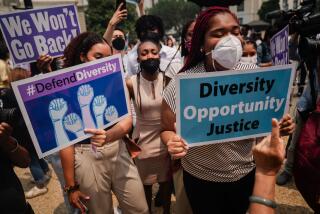Op-Ed: Implicit bias puts lives in jeopardy. Can mandatory training reduce the risk?

The California State Assembly is preparing to vote on three bills to require mandatory training on implicit bias for law enforcement officers, medical professionals, judges and trial lawyers.
The legislation singles out those professions because they are roles in which unconscious biases might put the lives of others in jeopardy. But the truth is, we all carry around unconscious stereotypes that can lead to differences in how we think about and treat others.
Research has shown that women are more likely to survive a heart attack when seen by female physicians; prosecutors are more likely to charge black suspects than white suspects in similar cases; and blacks and Latinos are more likely to be searched by police during traffic stops, even when searches of white motorists are more likely to turn up contraband.
Unconscious bias can influence decision-making without malice or bad intent. Yet its consequences can be just as devastating as the harm done by explicit racism, sexism or homophobia.
Despite the fact that anti-bias training seems to be everywhere these days, we know surprisingly little about its effectiveness.
Decades of studying and reporting on these issues as, respectively, a professor and a journalist have taught us that unconscious bias infiltrates every arena of life. It can make the difference in whether a rambunctious preschooler is celebrated or scolded, and it can influence how house hunters assess the value of a home, devaluing houses occupied by African Americans.
Making implicit-bias training mandatory for police, judges and doctors — whose evaluations and decisions are sometimes matters of life and death — certainly sends a strong signal that, as a society, we care about this issue and want to protect those who might be harmed by bias.
What’s less clear is whether a training mandate can deliver on that.
Despite the fact that anti-bias training seems to be everywhere these days, we know surprisingly little about its effectiveness. Most training programs have not been rigorously evaluated, and where they have been, results are, at best, mixed.
Part of the problem is that we have no agreed-upon definition of what success looks like. Evaluation of bias training in the workplace up to now has consisted mostly of asking participants whether they liked the process.
The three bills under consideration in California would go further, requiring training to be aimed not only at recognizing bias, but also at providing participants with strategies to reduce it.
This is a noble effort. And if we take it up, we ought to proceed in a way that advances knowledge. We should require not just earnest discussion, but also measurable results. This could be a great opportunity to understand what bias training can and cannot do, and to figure out what it takes to promote broad and lasting change.
Teaching and learning about implicit bias is a balancing act that has to be calibrated. Most training stresses how pervasive unconscious prejudices are, an approach intended to dilute resistance and allow participants to engage honestly. But the very path to making implicit bias non-threatening may also normalize it in a way that makes it harder to eradicate.
Research shows that when something is regarded as normal, people cease to judge it harshly. So when bias is presented as an ordinary part of human functioning, that can lead us to care less about the dangers it presents and feel less motivated to do the work that clearing out our preconceptions requires.
Rather than focus solely on reducing the deep-seated biases of public servants, we should also encourage institutions to create the kind of environment that makes employees less likely to act on whatever prejudices they have.
We are all vulnerable to bias, but it is not something we exhibit or act on all the time. Research shows that it is more likely to surface under certain conditions: when we’re required to make split-second decisions; when we’re feeling fearful, threatened or cognitively depleted; when we fail to monitor our own behavior or use subjective standards to evaluate the behavior of others; when positive contact with members of other groups is limited; and when cultural norms in our social environment do not support positive contact.
Enter the Fray: First takes on the news of the minute »
Understanding the circumstances that unleash bias can arm organizations to make institutional changes that help deactivate it.
We’ve seen many instances in which better training or policies serve to mitigate bias-driven actions. In Oakland, for example, police stops of black motorists dropped by 43% — with no corresponding increase in crime — after the Police Department began requiring officers to document whether they’d had evidence tying a motorist to a particular crime before making a stop. The policy pushes them to rely on objective facts rather than hunches.
It’s not reasonable to expect that a day of training, or two or three or 10, will be enough to dismantle implicit assumptions that have percolated over a lifetime. Therefore, courts, hospitals and law enforcement agencies also have to be willing to examine conditions in their organizations and make changes to reduce opportunities for bias to emerge.
Ultimately, what matters most is not whether bias training reduces prejudice in the workplace. The goal should be to reduce the likelihood that ingrained biases will be triggered in high-stakes situations, magnifying racial, economic and health disparities.
The proposed training is laudable because it focuses our attention on unaddressed harms. But to make a difference, it will need to be more than a gesture of commitment.
Jennifer L. Eberhardt is a professor of psychology at Stanford University and author of “Biased: Uncovering the Hidden Prejudice That Shapes What We See, Think, and Do.” Sandy Banks is a former Los Angeles Times reporter, editor and columnist.
More to Read
A cure for the common opinion
Get thought-provoking perspectives with our weekly newsletter.
You may occasionally receive promotional content from the Los Angeles Times.










